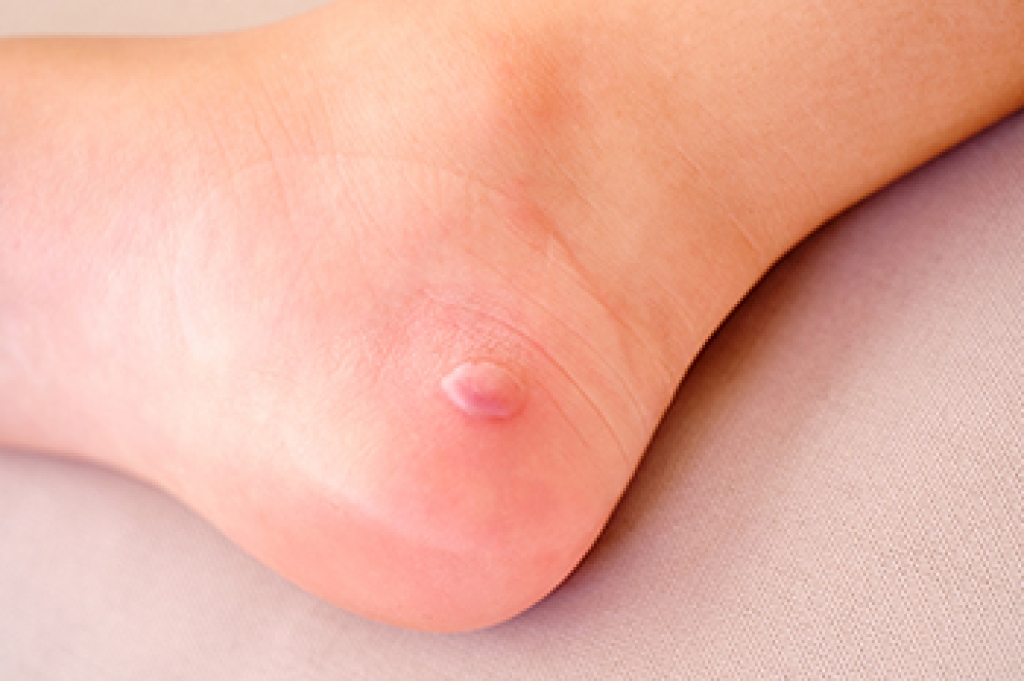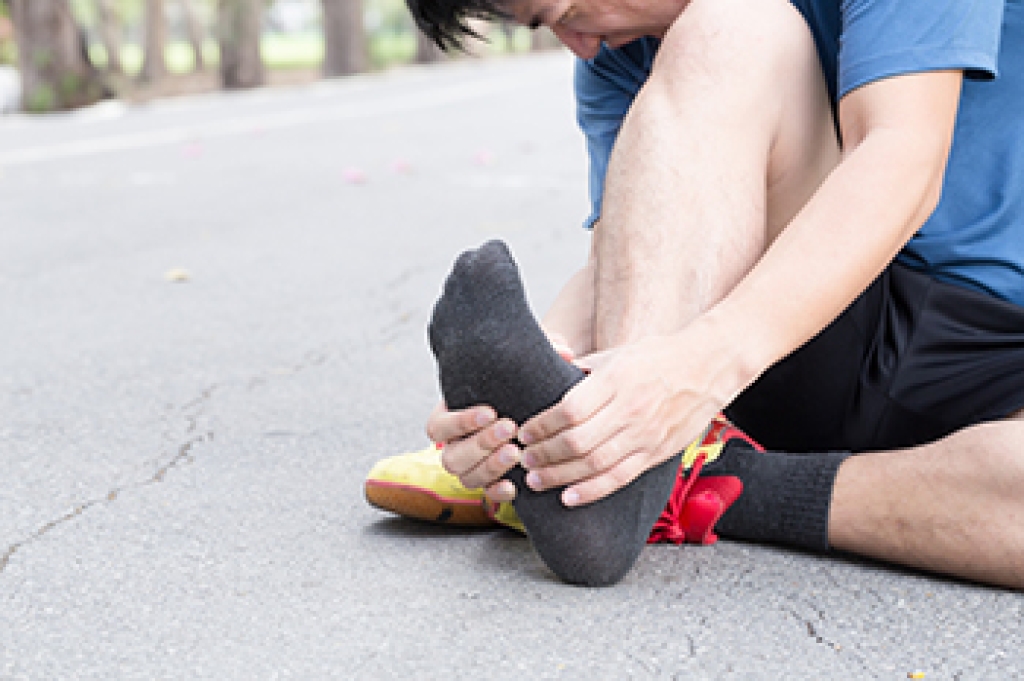Blog
Blog
The Origins of Foot Blisters

Foot blisters are pockets of fluid that can disrupt our stride, and arise from a multitude of sources, often interconnected. Friction, a primary culprit, occurs when shoes rub against the skin, creating heat and pressure that lead to the formation of blisters. Ill-fitting footwear, especially those that are too tight or too loose, exacerbates this friction. Moisture is another contributing factor, as damp conditions soften the skin, making it more susceptible to friction-related injuries. Prolonged periods of standing or walking intensify these forces, increasing the likelihood of blister formation. Foot deformities or irregularities, such as bunions or hammertoes, can also contribute by causing uneven pressure distribution. It is helpful to know the reason a blister has formed on your foot. If you have one or multiple foot blisters, it is suggested that you confer with a podiatrist who can guide you toward effective prevention methods.
Blisters are prone to making everyday activities extremely uncomfortable. If your feet are hurting, contact one of our doctors of Favor Foot Ankle Leg & Wound Center. Our doctors can provide the care you need to keep you pain-free and on your feet.
Foot Blisters
Foot blisters develop as a result of constantly wearing tight or ill-fitting footwear. This happens due to the constant rubbing from the shoe, which can often lead to pain.
What Are Foot Blisters?
A foot blister is a small fluid-filled pocket that forms on the upper-most layer of the skin. Blisters are filled with clear fluid and can lead to blood drainage or pus if the area becomes infected.
How Do Blisters Form?
Blisters on the feet are often the result of constant friction of skin and material, usually by shoe rubbing. Walking in sandals, boots, or shoes that don’t fit properly for long periods of time can result in a blister. Having consistent foot moisture and humidity can easily lead to blister formation.
Prevention & Treatment
It is important to properly care for the affected area in order to prevent infection and ease the pain. Do not lance the blister and use a Band-Aid to provide pain relief. Also, be sure to keep your feet dry and wear proper fitting shoes. If you see blood or pus in a blister, seek assistance from a podiatrist.
If you have any questions, please feel free to contact our office located in South Amboy, NJ . We offer the newest diagnostic and treatment technologies for all your foot care needs.
Factors for Choosing Running Shoes

Finding the perfect pair of running shoes is essential for a comfortable and injury-free running experience. When shopping for running shoes, consider support needs based on your foot's pronation, whether it is on the inside, outside, or neutral. This determines if you require stability or neutral shoes. Pay attention to key elements of the shoe's upper, including the ankle collar, heel counter, saddle, and toe box, ensuring they provide proper support without causing irritation. Cushioning is another important factor, with options like max, mid, and light-cushioning. When it comes to sizing, choose a shoe that is a half size larger than your actual foot size to allow a thumb's width space between your longest toe and the shoe's end. This extra room reduces friction, minimizes the risk of blisters, and accommodates foot swelling during runs. For help in determining the right type of running shoe, it is suggested that you schedule an appointment with a podiatrist to evaluate your foot, stride, and gait, as well as treating any existing foot problems.
If you are a runner, wearing the right running shoe is essential. For more information, contact one of our doctors from Favor Foot Ankle Leg & Wound Center. Our doctors can provide the care you need to keep you pain-free and on your feet.
Choosing the Right Running Shoe for Your Foot Type
To increase performance and avoid the risk of injury, it is important to choose the right running shoe based on your foot type. The general design of running shoes revolves around pronation, which is how the ankle rolls from outside to inside when the foot strikes the ground.
- Neutral runners are able to choose from a wide variety of shoes, including minimalist shoes or even going barefoot.
- Runners who overpronate, or experience an over-abundance of ankle rolling, should choose shoes that provide extra motion control and stability.
- Runners who underpronate, or supinate, have feet that have high arches and lack flexibility, preventing shock absorption. They require shoes with more flexibility and cushion.
If you have any questions, please feel free to contact our office located in South Amboy, NJ . We offer the newest diagnostic and treatment technologies for all your foot care needs.
Heel Pain in Middle-Aged and Older Adults

Heel pain is a common and debilitating issue that often affects middle-aged and older adults. This condition, often attributed to plantar fasciitis, can have a significant impact on the quality of life for individuals in these age groups. As people age, the tissues in their feet, including the plantar fascia, tend to lose elasticity and become more prone to inflammation and injury. This can lead to the development of heel pain, characterized by discomfort and tenderness in the bottom of the heel, particularly in the morning or after periods of rest. Several factors contribute to heel pain in middle-aged and older adults, including changes in foot structure, reduced flexibility, and the cumulative effects of wear and tear on the feet over time. Additionally, chronic conditions like osteoarthritis, diabetes, and vascular issues can exacerbate heel pain in this population. Managing heel pain in middle and older adults often involves a combination of conservative treatments, such as proper footwear, orthotics, stretching exercises, and anti-inflammatory medications. In some cases, medical interventions like corticosteroid injections may be necessary to alleviate the pain and improve mobility. If you are in this age group and suffer from heel pain, it is suggested that you consult with a podiatrist for a proper diagnosis and relief options.
Many people suffer from bouts of heel pain. For more information, contact one of our doctors of Favor Foot Ankle Leg & Wound Center. Our doctors can provide the care you need to keep you pain-free and on your feet.
Causes of Heel Pain
Heel pain is often associated with plantar fasciitis. The plantar fascia is a band of tissues that extends along the bottom of the foot. A rip or tear in this ligament can cause inflammation of the tissue.
Achilles tendonitis is another cause of heel pain. Inflammation of the Achilles tendon will cause pain from fractures and muscle tearing. Lack of flexibility is also another symptom.
Heel spurs are another cause of pain. When the tissues of the plantar fascia undergo a great deal of stress, it can lead to ligament separation from the heel bone, causing heel spurs.
Why Might Heel Pain Occur?
- Wearing ill-fitting shoes
- Wearing non-supportive shoes
- Weight change
- Excessive running
Treatments
Heel pain should be treated as soon as possible for immediate results. Keeping your feet in a stress-free environment will help. If you suffer from Achilles tendonitis or plantar fasciitis, applying ice will reduce the swelling. Stretching before an exercise like running will help the muscles. Using all these tips will help make heel pain a condition of the past.
If you have any questions, please feel free to contact our office located in South Amboy, NJ . We offer the newest diagnostic and treatment technologies for all your foot care needs.
How Weight Can Affect Foot Health

Numerous studies now highlight the connection between body weight and foot health. They suggest that a high body mass index, or BMI, can profoundly influence foot structure and function, thereby increasing the risk of painful conditions. The correlation between BMI and foot pain is well-documented. Research underscores the increased likelihood of abnormal plantar pressures, altered foot function, and changes in foot structure among individuals classified as obese, with a BMI of 30 or higher, or overweight, with a BMI between 25 and 29. These findings also reveal a heightened susceptibility among heavier individuals to foot complications, such as osteoarthritis, tendinitis, and plantar fasciitis, which can significantly affect their quality of life. Podiatrists now face the challenge of tailoring their approaches to foot care for patients with higher BMIs, considering factors like decreased tolerance for high-impact exercise and altered plantar pressures. This shift may influence the prescription of non-aerobic exercise and the recommendation of stiffer, thicker orthotic devices. If you have concerns about foot or ankle pain that may be related to weight, it is suggested that you schedule an appointment with a podiatrist.
Obesity has become very problematic at this point in time and can have extremely negative effects on the feet. If you’re an obese individual and are concerned about your feet, contact one of our doctors from Favor Foot Ankle Leg & Wound Center. Our doctors can provide the care you need to keep you pain-free and on your feet.
Obesity and Your Feet
Since your feet are what support your entire weight when standing, any additional weight can result in pain and swelling. Being overweight is one of the main contributors to foot complications.
Problems & Complications
Extra Weight – Even putting on just a few extra pounds could create serious complications for your feet. As your weight increases, your balance and body will shift, creating new stresses on your feet. This uneven weight distribution can cause pain, even while doing the simplest tasks, such as walking.
Diabetes – People who are overweight are at serious risk of developing type-2 diabetes, which has a drastic impact on the health of your feet. As you get older, your diabetes might worsen, which could lead to loss of feeling in your feet, sores, and bruises. You could also become more prone to various infections.
Plantar fasciitis – Pressure and stress that is placed on muscles, joints, and tendons can trigger plantar fasciitis, which is an inflammation of tissue that forms along the bottom of the foot.
If you have any questions, please feel free to contact our office located in South Amboy, NJ . We offer the newest diagnostic and treatment technologies for all your foot care needs.
Blog Archives
- 2025
- 2024
- 2023
- 2022
- 2021

